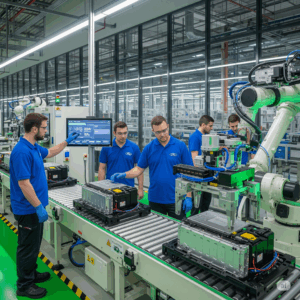Ford EV Investment Marks Historic Shift in Auto Industry
Ford Motor Company has unveiled a monumental Ford EV investment worth $5 billion, calling it the company’s “next Model T moment.” The move will fund a new assembly line and battery production facilities to build electric vehicles (EVs), including a yet-to-be-named pickup truck that will be the most affordable in its category.
Ford’s announcement, made Monday, outlines plans to secure or add 4,000 US jobs while introducing a redesigned manufacturing approach inspired by the legacy of the original Model T — the car that transformed the global auto industry in the early 20th century.
Affordable Electric Pickup to Lead the Charge
At the heart of this Ford EV investment is the development of a $30,000 electric pickup truck — a sharp contrast to the company’s current F-150 Lightning, which starts at approximately $55,000. The new battery technology, smaller and lighter than previous models, will make this pricing possible while also improving efficiency. The first models are expected to roll off the production line by 2027.
Job Creation and Modernized Assembly Lines
Of the $5 billion investment, $2 billion will go toward upgrading Ford’s Louisville assembly plant to produce the next generation of EVs. This upgrade will secure 2,200 hourly jobs, although the shift from gasoline-powered SUVs to EVs will require around 600 fewer positions due to the efficiency of the new assembly process.
Ford CEO Jim Farley addressed concerns over job reductions, explaining that many affected employees could transition to roles at the nearby Kentucky Truck Plant or other facilities. Additionally, 1,700 new jobs will be created in Michigan for battery production.
Michigan Battery Plant and New Production Design
Part of the Ford EV investment includes further development of a Michigan battery plant, first announced in 2023. This facility will produce the new lighter batteries that enable the $30,000 pickup’s competitive pricing.
Ford will also introduce a groundbreaking “tree layout” assembly line, replacing the century-old straight-line model. This new configuration will connect multiple smaller lines into one integrated system, allowing parts to merge more efficiently. The result is expected to lower production costs, speed up manufacturing, and reduce strain on workers.
Balancing Innovation with Political and Economic Challenges
Ford’s investment comes amid complex political and economic conditions. The Trump administration has eliminated federal tax credits for EV buyers and rolled back Biden-era emissions regulations, potentially affecting demand. At the same time, the company faces steep tariffs on imports, which have fueled a trend of reshoring manufacturing to the US.
While Ford builds more cars in America than any other automaker, it has no plans to shift production of the Ford Mustang Mach-E from Mexico. Despite strong revenue growth in its EV division — nearly tripling in the first half of this year compared to last — the company reported a $2.2 billion loss in the segment.
A Turning Point for Ford and the EV Market
Doug Field, Ford’s chief EV digital and design officer, likened the move to the launch of the original Model T. “We think today will be a turning point for Ford Motor Company and the auto industry,” he said.
By coupling affordable EVs with innovative manufacturing techniques, Ford aims to make electric mobility accessible to a wider range of customers, reinforcing its position as a leader in the transition to sustainable transportation.
Read more groundbreaking business stories in top business magazine IMPAAKT.













